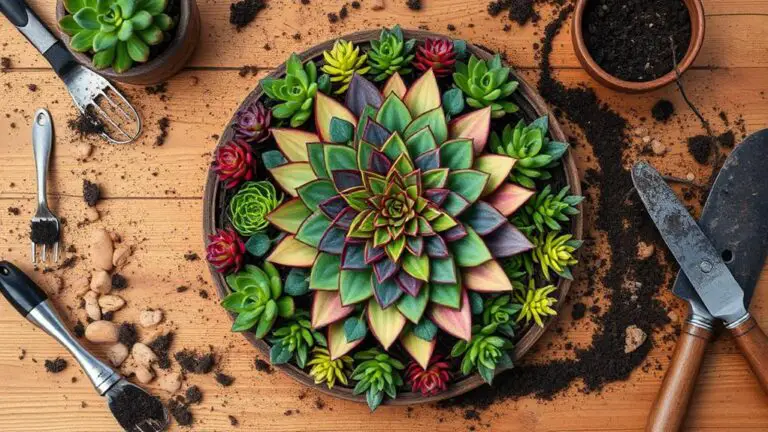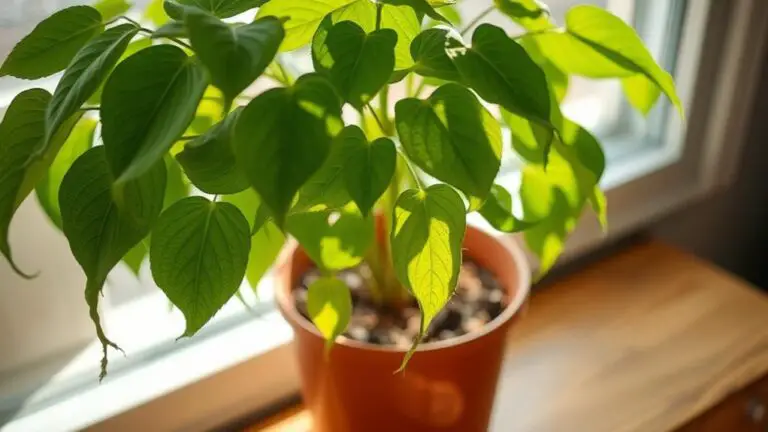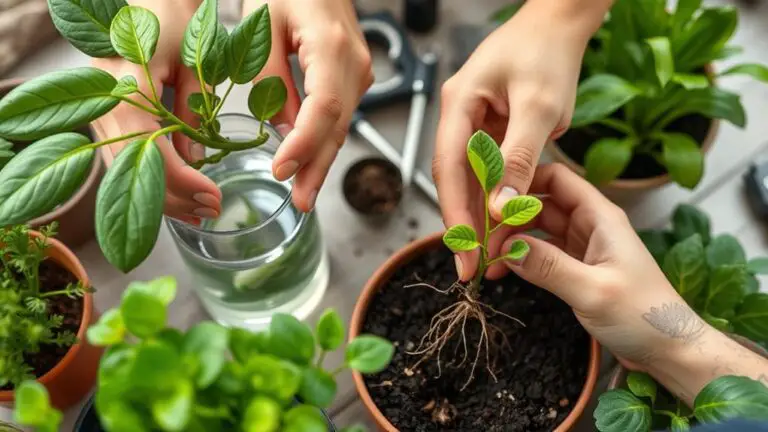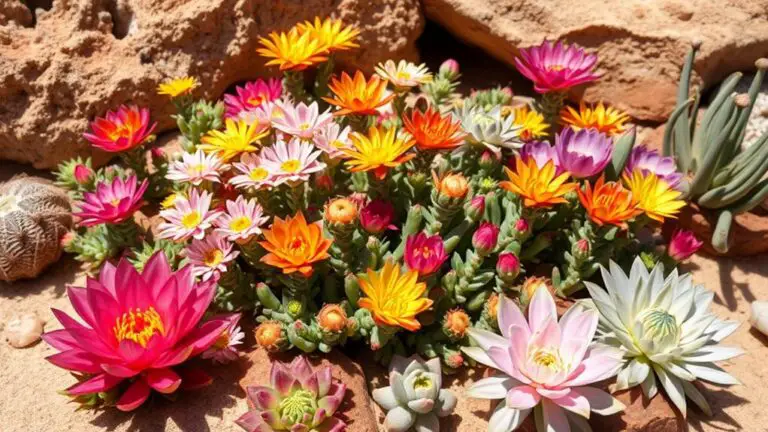10 Tips to Speed Up Cactus Growth
If you're looking to speed up your cactus growth, you'll need to go beyond basic care and focus on some key strategies. Choosing the right soil and optimizing sunlight exposure are just a start. You'll also need to water smartly and use proper containers to guarantee healthy development. Maintaining an ideal temperature range and fertilizing carefully during the growing season are essential, too. Ever wondered how pruning and pest monitoring can make a difference? And what about rooting hormones for propagation? Let's explore these tips and see how each can transform your cactus-growing experience.
Choose the Right Soil
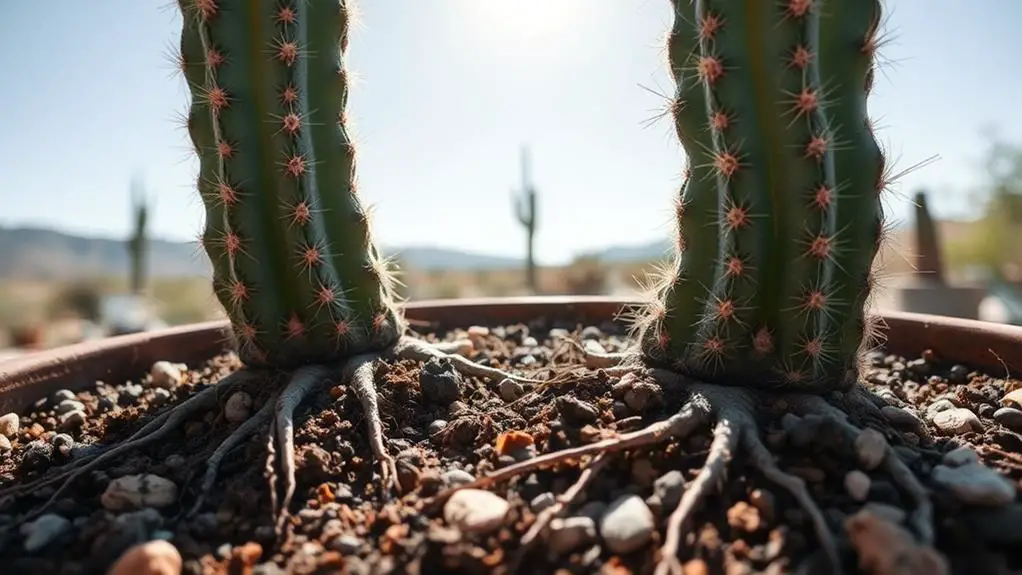
Choosing the right soil is vital for the health and growth of your cactus. You need to guarantee you're using well-draining soil to prevent water retention and root rot. A great way to achieve this is by mixing sandy soil with perlite. This combination creates a porous texture that lets excess water escape easily, keeping your cactus roots healthy.
Opting for a cactus-specific potting mix can make a big difference. These mixes usually contain minimal organic matter, enhancing soil aeration and guaranteeing proper drainage. This helps your cactus roots develop well without the risk of mold or rot.
It's also important to regularly check the soil moisture levels. Avoid using heavy compost, as it retains too much water.
Repotting your cactus every couple of years into a slightly larger pot gives the roots space to expand and absorb nutrients more effectively. This promotes faster growth.
Always choose pots made of porous materials with drainage holes. These features help control moisture and prevent waterlogging, which is vital for your cactus's health.
Optimize Sunlight Exposure

To help your cactus thrive, make certain it gets at least six hours of direct sunlight each day by placing it near a south or west-facing window.
Rotate your cactus regularly to guarantee even light exposure and prevent it from leaning.
If natural sunlight is limited, especially in winter, supplement with full-spectrum grow lights to keep your cactus healthy and growing steadily.
Ensure Direct Sunlight
Guaranteeing your cacti receive direct sunlight is essential for their health and growth. Cacti need a minimum of six hours of direct sunlight daily to thrive and achieve robust growth. Positioning them in south or west-facing windows is ideal, as these spots usually get the most sunlight during the day.
When your cacti absorb enough light, they grow strong and healthy, avoiding the weak, leggy appearance caused by insufficient light. If your cacti don't get enough sunlight, their growth can be stunted. You might notice your plants becoming elongated and frail instead of sturdy and vibrant.
To prevent this, guarantee they get the right amount of direct sunlight each day. However, be cautious when moving indoor cacti outside. Gradually acclimate them by first placing them in indirect sunlight. This slow introduction helps avoid sunburn, which can damage your plants.
Rotate for Even Exposure
Rotating your cacti every few weeks is essential for maintaining their overall health and balanced growth. By doing this, you guarantee that all sides of your cactus receive equal sunlight, which prevents lopsided growth and promotes a more uniform shape.
Cacti need at least six hours of direct sunlight daily, and rotating them helps achieve this requirement evenly across their surface area.
When you rotate your cactus, you're helping it stay healthy and preventing stunted growth caused by insufficient light on one side. Different cactus species may have varying light needs, so consider their natural habitats when determining how often to rotate.
Regular rotation also helps prevent sunburn on the most exposed areas of the plant.
Here are some key points to remember:
- Rotate your cactus every few weeks to guarantee even sunlight exposure.
- Watch for signs of uneven growth and adjust rotation frequency as needed.
- Understand the specific light needs of your cactus species.
- Avoid placing your cactus in a spot where one side receives too much or too little light.
- Regularly check for sunburn and make adjustments to prevent it.
Use Grow Lights
Making the most of sunlight exposure is crucial for healthy cactus growth, especially when natural light is limited. Cacti need at least six hours of full sun daily. Sometimes, that's not possible due to weather or indoor conditions. This is where grow lights come in handy.
Using full-spectrum grow lights can help supplement natural light during darker months or in low-light environments. It's important to position these lights 12 to 18 inches above your cactus. This distance provides the right light intensity without causing heat stress or sunburn. LED grow lights are a great choice since they're energy-efficient and emit less heat, making them safe for prolonged use.
Remember to rotate your cacti under the grow lights every few weeks. This guarantees even light exposure and prevents uneven growth. Also, monitor the light intensity and adjust the duration based on the specific needs of your cactus species. This careful attention will promote ideal growth.
Lastly, don't forget to water your cactus properly. Even with the best light, cacti need the right amount of water to thrive. By combining good light exposure with proper watering, you'll see your cactus grow strong and healthy.
Water Smartly
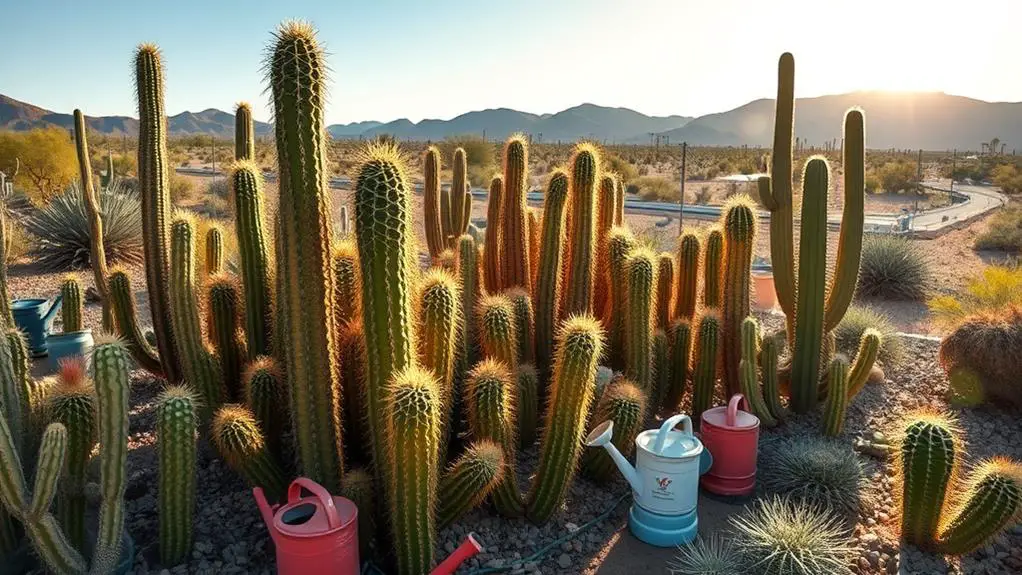
When it comes to watering your cactus, it's important to get the timing just right.
Let the soil dry out completely between watering sessions to prevent root rot, using the soak-and-dry method for best results.
Make certain your pots have good drainage and keep an eye on the soil moisture to guarantee your cactus stays healthy and happy.
Optimize Watering Schedule
Watering cacti smartly is crucial for their health and growth. To optimize your watering schedule, you need to understand when and how much to water.
Start by soaking the soil thoroughly during watering sessions until you see drainage. Then, let the soil dry completely before you water again. This is especially important because cacti are prone to overwatering, which can be fatal.
Here's a simple guide to keep your cactus thriving:
- Check the top 3 inches of soil for dryness before each watering session.
- Water every two weeks in summer, when they grow faster, and every 4-6 weeks in winter.
- Use the soak-and-dry method to guarantee water reaches the roots without causing waterlogging.
- Adjust watering frequency based on seasons and environment. Outdoor cacti mightn't need extra water during dry spells.
- Look for signs of dehydration, like shriveled stems, to decide when to water.
Ensure Proper Drainage
To guarantee your cactus thrives, proper drainage is crucial. Cacti need well-draining soil to prevent waterlogging and root rot, both of which can quickly kill your plant. Use pots made of porous materials like clay or terracotta, which help water escape. Confirm these pots have drainage holes to prevent excess water from sitting around the roots.
Water smartly by thoroughly soaking your cactus until water drains out, then let the soil dry out between watering. Depending on the season, this means watering every couple of weeks in summer and every 4-6 weeks in winter. Implement the soak-and-dry method to maintain ideal moisture levels, allowing the top 3 inches of soil to dry out before re-watering.
Drainage Tips Table
| Material | Benefit | Frequency |
|---|---|---|
| Porous pots | Enhances airflow, reduces rot | Always |
| Drainage holes | Prevents stagnant water | Crucial |
| Soak-and-dry | Maintains moisture balance | Regularly |
Regularly check for signs of over-watering, like yellowing or mushy stems. These signs mean you need to adjust your watering practices immediately. By focusing on proper drainage, you'll provide your cactus the perfect environment to grow and thrive.
Monitor Soil Moisture
Keeping a close eye on soil moisture is essential for the health of your cactus. Overwatering is a leading cause of cactus death, so it's important to get it right. You should water your cactus only when the top 3 inches of soil are completely dry. The soak-and-dry method is perfect for this. Water thoroughly until you see drainage, then let the soil dry out completely before the next watering.
Here are some tips to help you monitor soil moisture and water smartly:
- Use a moisture meter: This tool helps you accurately gauge soil moisture levels, guaranteeing you water only when necessary.
- Check soil dryness: Insert your finger or a stick into the soil to test for dryness at 3 inches deep.
- Adjust watering frequency: Indoor cacti usually need watering every couple of weeks in summer and every 4-6 weeks in winter.
- Look for dehydration signs: A shriveled cactus may need water, even if the soil is slightly moist.
- Prevent sunburn: Confirm your cactus has the right balance of light and water to avoid stress.
Use Proper Containers
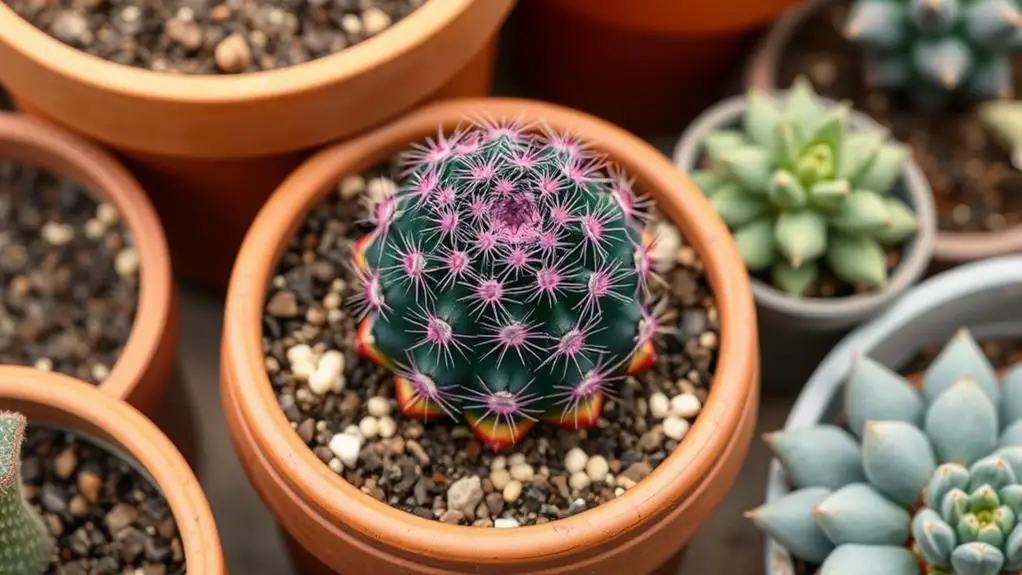
While choosing the right container for your cactus, it's essential to focus on materials and design that promote healthy root development. Opt for pots made of porous materials like terracotta. These materials allow airflow and help to prevent moisture buildup, which is vital for the health of your cacti's roots.
Make sure your container has adequate drainage holes. This feature lets excess water escape, reducing the risk of root rot. A pot that's 1.5 times wider than the cactus's root ball provides enough space for root growth, preventing overcrowding. Remember, cacti roots need room to spread out and grow strong.
Repotting your cacti every couple of years or when they outgrow their containers is also important. Doing this maintains ideal soil conditions and promotes healthy growth.
When repotting, use a well-draining cactus potting mix. A blend that includes sand and perlite works best. This type of soil mix supports proper moisture management and nutrient absorption, ensuring your cactus gets what it needs to thrive.
Maintain Ideal Temperature
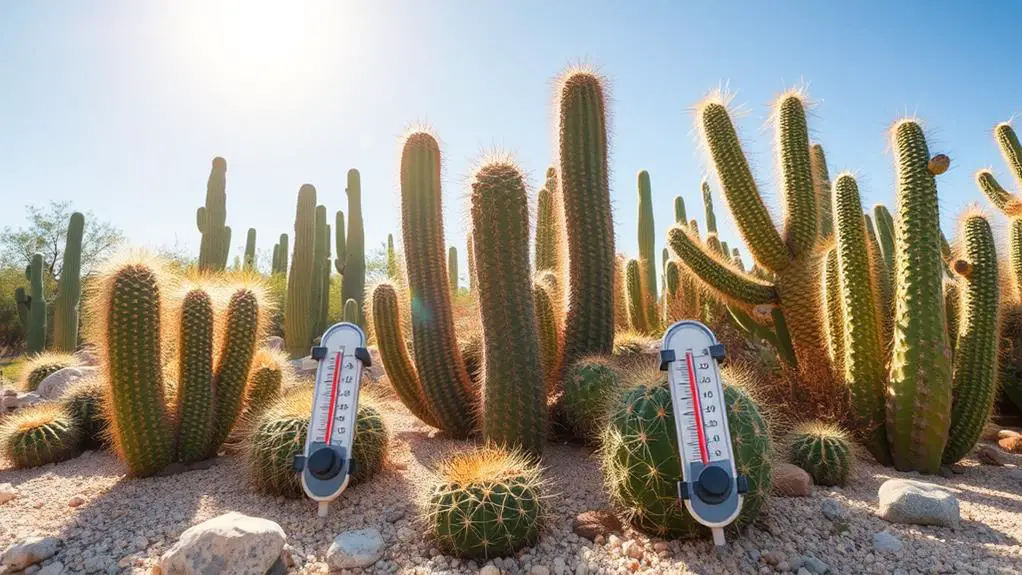
To help your cactus thrive, keep the temperature between 60 and 75°F (15 to 24°C) to avoid stressing the plant.
Make sure it's not near drafts or direct heating and cooling sources, as sudden temperature changes can stunt growth.
During the growing season, aim for temperatures between 70 and 100°F (21 to 38°C) to encourage active growth, and adjust its placement to maintain consistent warmth.
Consistent Temperature Range
Maintaining a consistent temperature range is essential for the health and growth of your cacti. These resilient plants thrive best in a temperature range of 60 to 75°F (15 to 24°C), which closely mimics their native arid habitats.
Guaranteeing this consistency, especially during the active growing season in spring and summer, considerably boosts your cacti's growth rates.
To achieve this, you should:
- Monitor the temperature: Use a thermometer to regularly check the environment around your cacti.
- Avoid drafts and vents: Keep your cacti away from heaters, air conditioning vents, and drafty windows to prevent sudden temperature fluctuations.
- Utilize heating mats: If indoor temperatures are unstable, heating mats can help maintain a steady warmth.
- Consider grow lights: These can provide both light and warmth, creating a stable micro-environment for your cacti.
- Adjust for seasons: During dormancy in fall and winter, keep temperatures above 50°F (10°C) to guarantee they stay healthy.
Avoid Temperature Extremes
Extreme temperature fluctuations can severely stress your cacti, leading to stunted growth or even death. To promote ideal growth, it's important to keep your cacti within their preferred temperature range of 60 to 75°F (15 to 24°C). This range closely mimics their native habitats and helps them thrive.
First, avoid placing your cacti near drafts, heating vents, or air conditioning units. These spots can create localized temperature extremes that aren't healthy for your plants. Consistency is key.
During the winter months, make sure temperatures don't drop below 50°F (10°C). If it gets too cold, your cacti might stay dormant for too long, which can hinder their growth when warmer weather returns.
Monitoring the temperature in your home and making adjustments as needed will help maintain an ideal environment. If you notice temperature extremes, move your cacti to a more stable location.
For instance, a room with consistent ambient temperature or away from windows that might get too chilly at night.
Seasonal Adjustments Needed
As you safeguard your cacti from temperature extremes, it's just as important to adapt to seasonal changes to maintain the ideal environment. Cacti thrive best in temperatures between 60 to 75°F, similar to their natural habitats.
However, as seasons change, you'll need to make some adjustments to keep your plants happy and growing.
During colder months, maintaining a consistent temperature is essential. Fluctuations can cause temperature-related stress, hindering your cacti's growth. Here are some tips to help:
- Avoid drafts: Keep your cacti away from windows that might let in cold air or areas with frequent drafts.
- Stay clear of heating sources: Don't place your cacti near radiators or vents that blow hot air, as this can dry them out.
- Adjust light exposure: Make sure your cacti get direct sunlight daily, which might mean moving them to sunnier spots as the angle of the sun changes.
- Use a thermometer: Regularly check the temperature around your cacti, especially if they're near windows or doors.
- Consider grow lights: If natural light is insufficient during winter, grow lights can provide the extra boost they need.
Enhance Airflow

To guarantee your cacti thrive, promoting good airflow is essential. Adequate airflow helps prevent fungal diseases and encourages healthy growth. Make sure to space your cacti properly; this will allow air to circulate around each plant, reducing the risk of disease.
Place your cacti in well-ventilated areas, but avoid drafty windows or heating and cooling vents. These spots can create inconsistent air circulation, which isn't ideal for your plants.
Rotating potted cacti periodically is another great way to make certain they get even exposure to air and light. This simple step can greatly enhance their growth potential.
Using porous pot materials, like terracotta, also helps. Terracotta pots allow better airflow to the roots compared to plastic pots, which can trap moisture and lead to root rot.
Monitoring humidity levels is key, too. Cacti prefer low humidity, as stagnant air can harm them. By keeping the humidity low, you'll promote a healthier environment for your plants.
Following these tips will help your cacti grow stronger and healthier, making your gardening efforts more rewarding. Remember, good airflow is the foundation of a thriving cactus garden.
Fertilize Carefully
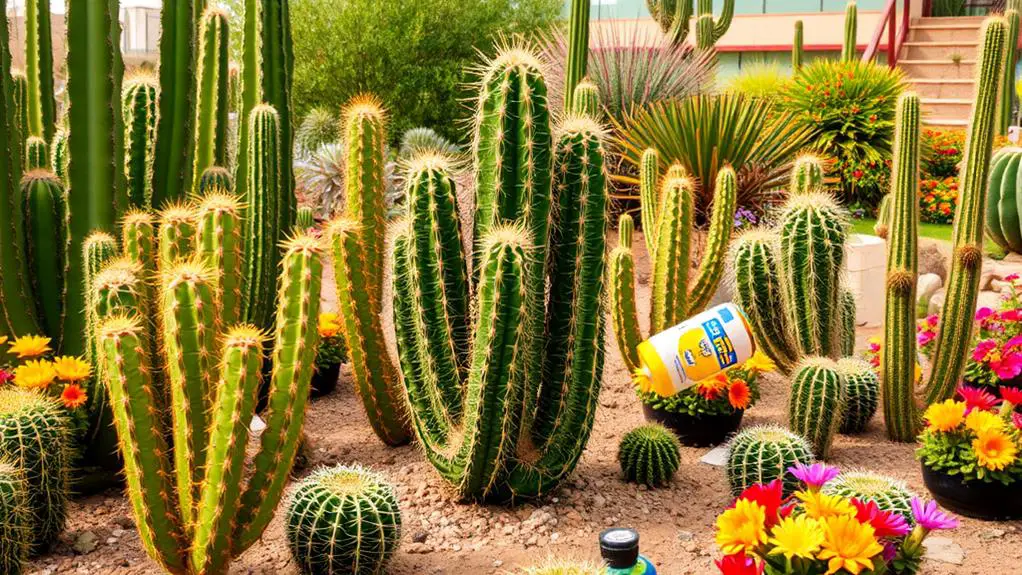
Caring for your cacti includes the important step of fertilizing them carefully to guarantee they thrive. Fertilizing during the growing season, which is spring and summer, is essential.
Use a cactus-specific fertilizer to support healthy growth without causing nutrient burn. Apply it sparingly, about once a month, and always make sure it's diluted to prevent over-fertilization. Overdoing it can lead to weak and leggy growth, which you want to avoid.
Here are some key tips to keep in mind:
- Start feeding after a month of planting. Options like Miracle-Gro Succulent Plant Food work well for potted cacti, while Miracle-Gro Water Soluble All Purpose Plant Food is excellent for outdoor varieties.
- Monitor your cacti's health continuously. Adjust your fertilization routine based on how your plants respond.
- Avoid fertilizing in fall and winter. During these dormant seasons, fertilizing can cause unnecessary stress and hinder growth.
- Use a balanced approach. Make sure the fertilizer contains the important elements your cacti need.
- Keep the balance. Remember, over-fertilization can disrupt the delicate nutrient balance necessary for cactus health.
Prune Strategically
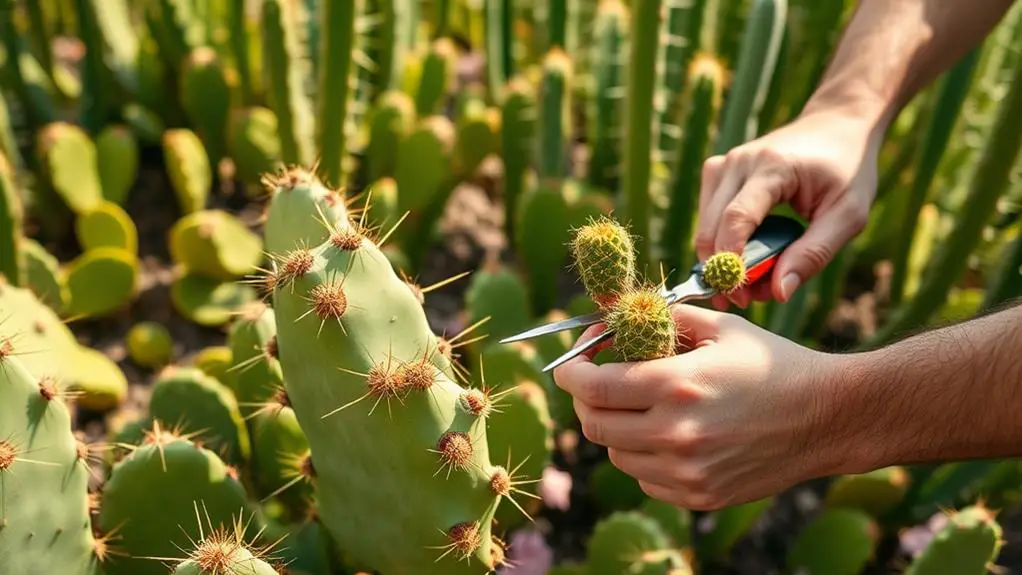
Pruning your cacti strategically can breathe new life into your plants, encouraging robust growth and a healthier structure. By removing older, less productive sections, you allow the cactus to redirect its energy towards more vibrant areas. This not only helps the plant grow faster but also promotes root development.
To prune strategically, you should do this during the active growing season, which is spring and summer. This timing guarantees that your cactus recovers quickly and responds well to the pruning. Always use clean, sharp tools to make precise cuts, minimizing damage and reducing the risk of infection. Dirty or dull tools can harm your cactus, making it harder for the plant to heal.
Prune sparingly, though. Too much cutting can stress the plant and slow down growth, which is the opposite of what you want. Focus on removing any excessively tall or leggy sections to encourage a more compact shape and healthier overall appearance.
This approach not only enhances the look of your cactus but also strengthens it.
Monitor for Pests
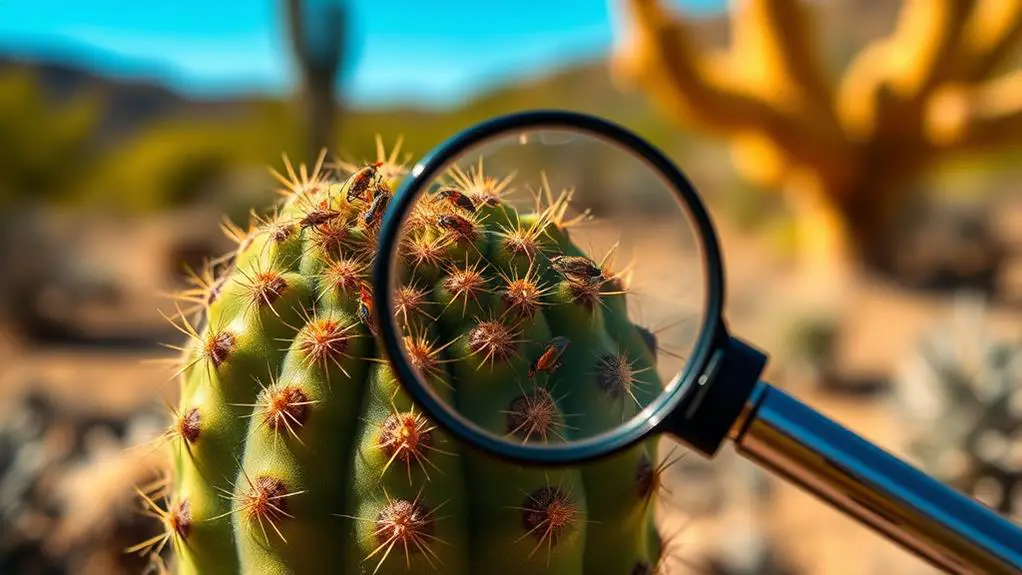
As you confirm your cactus is pruned and shaped for peak growth, keeping an eye out for pests becomes your next significant task. Regularly inspecting your cacti can save you a lot of trouble down the line. Common pests like spider mites, mealybugs, and scale insects can hinder your cactus's growth and overall health.
To catch these problems early, look for visible symptoms of infestation:
- Webbing from spider mites.
- Sticky residue left by mealybugs.
- Discolored spots indicating scale insects.
- Any signs of deformity or unexpected changes in your cactus.
- Check the undersides of leaves where pests often hide.
If you spot any of these signs, act quickly. Using insecticidal soap or neem oil can help manage these pests effectively. Follow the product instructions carefully to confirm you're using them correctly.
Additionally, maintain good airflow around your cacti. Stagnant air can attract pests and lead to fungal diseases.
Maintaining a clean growing environment is also essential. Remove any debris or dead plant material around your cactus, as these can harbor pests.
Utilize Rooting Hormones
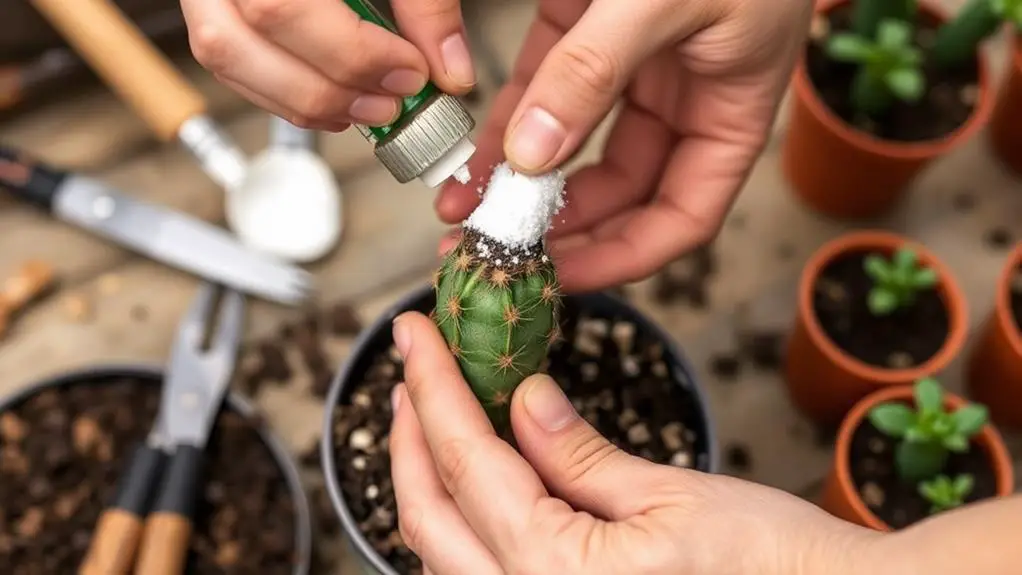
When you're looking to propagate your cactus, utilizing rooting hormones can be a game-changer. Rooting hormones, like auxins, can greatly enhance root development in cactus cuttings, giving you a head start on new growth. By applying rooting hormone to the cut end of your cactus cuttings, you're boosting the success rate of propagation. This means your cactus can develop roots faster, establishing itself more quickly.
To use rooting hormones, you can choose between powdered or liquid forms, both of which are available at garden centers. For the best results, dip the cut end of your cactus in the rooting hormone before placing it in well-draining soil. This step is vital as it guarantees ideal absorption and effectiveness, speeding up the rooting process.
Once you've planted your cutting, keep a close eye on the soil's moisture levels. Proper hydration is essential for newly rooted cacti, as it supports healthy new growth. Overwatering can be harmful, so strike a balance and water just enough to keep the soil slightly moist.
Frequently Asked Questions
How to Make Your Cactus Grow Fast?
To make your cactus grow fast, guarantee it gets six hours of sunlight daily, use well-draining soil, water thoroughly but infrequently, fertilize sparingly during spring and summer, and maintain a consistent temperature between 60 and 75°F.
Do Coffee Grounds Help Cactus Grow?
Yes, coffee grounds can help cacti grow by improving soil structure and providing a nitrogen boost. Use them sparingly—no more than 10-20% of the soil mix—and guarantee they're dried to avoid root rot and over-fertilization.
How Do You Stimulate Cactus Root Growth?
Use rooting hormones, choose well-draining soil with perlite or sand, and water sparingly. Maintain a temperature between 70°F to 100°F and guarantee good airflow to minimize humidity. These steps will stimulate your cactus's root growth effectively.
Why Do Cactus Grow so Slowly?
Cacti grow slowly because they conserve water and minimize energy usage to survive harsh arid conditions. Their thick, fleshy stems store water, and they use Crassulacean Acid Metabolism (CAM) for efficient, but slow, energy conversion.
Conclusion
By following these tips, you'll see your cacti thriving in no time. Choose the right soil, give them plenty of sunlight, and water them wisely. Don't forget to use proper containers and keep the temperature just right. Fertilize during the growing season and prune when needed. Keep an eye out for pests, and consider rooting hormones for propagation. With your care and attention, your cacti will grow faster and healthier. Happy gardening!



